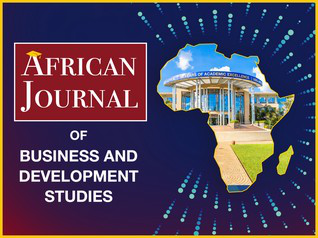Influence of Organizational Culture on Competitive Advantage of the Top 100 Medium-Sized Enterprises in Kenya
DOI:
https://doi.org/10.70641/ajbds.v2i1.167Keywords:
Competitive advantage, Organizational culture, Consistency cultureAbstract
While organizational culture is linked to competitive advantage, its specific configuration in high-performing SMEs in emerging economies remains poorly understood. This study addressed this gap by examining the role of organizational culture in enhancing competitive advantage among Kenya's top 100 medium-sized companies. Employing a descriptive cross-sectional design, the study collected data via a census approach from senior managers using an online questionnaire. Of the 407 questionnaires administered, 311 were fully completed and submitted. The research further utilized statistical methods, including correlation and regression analyses, via SPSS version 23 to analyze the data. The research revealed a compelling paradox: while the overall relationship between organizational culture and competitive advantage was positive and significant (β=0.590, t = 11.404, p < 0.05), the most compelling insight is that mission, involvement, and adaptability cultures emerged as critical drivers, while internal consistency, often considered a cornerstone of performance, showed no significant effect. The study concludes that the optimal path to competitive advantage for Kenyan SMEs is not a balanced cultural profile but rather a deliberate focus on these three core traits. These findings suggest that in volatile emerging markets, a premium is placed on strategic agility and empowerment over operational homogeneity.
References
Adekunle, O., & Ogunleye, O. (2019). The impact of corporate culture on the competitive advantage of small and medium scale enterprises in Nigeria.Journal of Business and Management, 21(12), 1–12.
Ali, A., Davis, E., Martinez, C., & Brown, L. (2024). The role of organizational culture in diving innovation and competitive advantage. International Journal of Management, Business, and Economics, 1(1), 1–6.
Balqis, B., & Riyanto, S. (2020). The effect of work culture and competitive advantage on the performance of culinary and service companies during the COVID-19 pandemic. International Journal of Innovative Science and Research Technology, 5(6), 547–550. DOI: https://doi.org/10.38124/IJISRT20JUN480
Bartosiewicz, A., & Kucharski, A. (2024). Indicators of port sustainability: The example of Baltic Sea container ports. Sustainable Development, 32(3),2371–2384. https://doi.org/10.1002/sd.2783 DOI: https://doi.org/10.1002/sd.2783
Bhuiyan, F., Rana, T., Baird, K., & Munir, R. (2023). Strategic outcome of competitive advantage from corporate sustainability practices: Institutional theory perspective from an emerging economy. Business Strategy and the Environment, 32(7), 4217–4243.https://doi.org/10.1002/bse.3362 DOI: https://doi.org/10.1002/bse.3362
Denison, D. (1990). Corporate Culture and Organizational Effectiveness. New York, NY: John Wiley & Sons.
East Africa Top 100. (n.d.). East Africa Top 100. Retrieved June 19, 2024, from https://eastafricatop100.com/
Elkington, J. (1994). Towards the sustainable corporation: Win-win-win business strategies for sustainable development. California Management Review, 36(2), 90–100. https://doi.org/10.2307/41165746 DOI: https://doi.org/10.2307/41165746
Harahap, M. A. K., Pratama, I. W. A., Diwyarthi, N. D. M. S., & Harsono, I. (2024). The effect of employee competence and organizational culture on competitive advantage in the tourism industry in Bali. West Science Interdisciplinary Studies, 2(3), 622–629. DOI: https://doi.org/10.58812/wsis.v2i03.741
Hussein, H., Albadry, O. M., Mathew, V., Al-Romeedy, B. S., Alsetoohy, O., Abou Kamar, M., & Khairy, H. A. (2024). Digital leadership and sustainable competitive advantage: leveraging green absorptive capability and eco-innovation in tourism and hospitality businesses. Sustainability, 16(13), 1–21. https://doi.org/10.3390/su16135371 DOI: https://doi.org/10.3390/su16135371
Kasema, R. (2023). Key failure factors of start-up women owned SMEs in service sector in Kigali: A principal component analysis approach. Vilakshan – XIMB Journal of Management, 20(2), 223–232. https://doi.org/10.1108/XJM-07-2021-0193 DOI: https://doi.org/10.1108/XJM-07-2021-0193
Kindström, D., Carlborg, P., & Nord, T. (2024). Challenges for growing SMEs: A managerial perspective. Journal of Small Business Management, 62(2), 700–723. https://doi.org/10.1080/00472778.2022.2082456 DOI: https://doi.org/10.1080/00472778.2022.2082456
Ma'aji, M. M., Shrubsall, R. S., & Anderson, E. O. (2023). Determinants of SME success or failure in frontier markets. International Journal of Banking and Finance, 18(1), 1–30. https://doi.org/10.32890/ijbf2023.18.1.1 DOI: https://doi.org/10.32890/ijbf2023.18.1.1
Nimfa, D. T., Latiff, A. S. A., Wahab, S. A., & Etheraj, P. (2021). Effect of organizational culture on sustainable growth of SMEs: mediating role of innovation competitive advantage. Journal of International Business and Management, 4(2),1–19. https://doi.org/10.37227/JIBM-2021-01-156 DOI: https://doi.org/10.37227/JIBM-2021-01-156
Odhiambo, J., & Owuor, J. (2020). The impact of corporate culture on the competitive advantage of small and medium enterprises in Kenya. Journal of Business and Management, 22(1), 1–12.
Otieno, A. O., Weda, C., & Olweny, T. (2023). Influence of demographic factors on the financial performance of small and medium-sized enterprises in Kajiado County, Kenya. Reviewed Journal International of Business Management, 4(1), 186-202. DOI: https://doi.org/10.61426/business.v4i1.84
Parmigiani, A., & Rivera-Santos, M. (2015). Sourcing for the base of the pyramid: Constructing supply chains to address voids in subsistence markets. Journal of Operations Management, 33, 60–70. https://doi.org/10.1016/j.jom.2014.10.007 DOI: https://doi.org/10.1016/j.jom.2014.10.007
Porter, M. E. (1985). Competitive Advantage: Creating and Sustaining Superior Performance. New York, NY: Free Press.
Prescah, F. M., Hadijah, N., Gorret, K., & Robert, M. (2018). Corporate culture as a tool for competitive advantage of small and medium enterprises in Uganda: A case study of the tourism and hospitality sector. Scholars Journal of Economics, Business and Management, 5(10), 972–976.
Wang, K., & Wang, T. (2024). Competition from informal firms and new‐to‐market product innovation: A competitive rivalry framework. Journal of Product Innovation Management, 41(4), 816–842. https://doi.org/10.1111/jpim.12712 DOI: https://doi.org/10.1111/jpim.12712
Wang, W., Zhang, D., Wang, H., Zhu, Q., & Morabbi Heravi, H. (2023). How do businesses achieve sustainable success and gain a competitive advantage in the green era? Kybernetes, 52(9), 3241–3260. https://doi.org/10.1108/K-07-2021-0614 DOI: https://doi.org/10.1108/K-07-2021-0614
Downloads
Published
How to Cite
Issue
Section
License
Copyright (c) 2025 Swabra Abdallah Soud, Maina Muchara & Joyce Ndegwa

This work is licensed under a Creative Commons Attribution-NonCommercial-ShareAlike 4.0 International License.





 This work is licensed under a
This work is licensed under a 